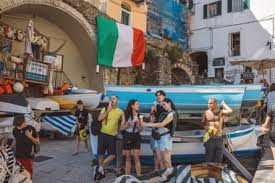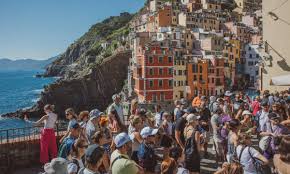‘We’re not anti-tourist’: Italy’s picturesque villages struggle to cope with deluge of Insta-visitors

The five villages of the Cinque Terre are determined to ensure the once sleepy area is not overwhelmed by mass tourism
Grappling with suitcases and rucksacks, the bewildered-looking crowd that piled off the train and onto the platform at Manarola, the second smallest of the five picturesque villages that make up Italy’s the Cinque Terre, could hardly move. But still the jovial Italian steward ushering them into a single file and towards the station’s narrow exit was telling them to hurry up.
“Quick … Manarola needs more tourists!” she said in English. Barely registering her irony, the visitors picked up the pace of their shuffle before dispersing towards the tiny marina to capture an Instagram-perfect photo on the rugged riviera coastline.
There was a time when Manarola’s year-round population, which has dwindled over the years to about 350, could take a peaceful afternoon nap.

“Older people like me were used to having a sleep at around four o’clock,” said Giancarlo Cielano, 80, as he nostalgically recalled his siestas of a bygone area. “But then, as more people came, we just couldn’t do it anymore. There were these constant voices and suitcases being rolled along the streets…we could no longer hear the sound of the sea.”
From Venice and Dubrovnik to Bali and Alaska, managing mass tourism is a dilemma facing many popular global destinations. In Italy, 2023 was a record year, with foreigners making up the vast majority of visitors for the first time since before the coronavirus pandemic. Great for the country’s coffers, not so good for the coveted hotspots struggling to strike a balance between the economic rewards and managing the huge flows.
Tourists in the town of Riomaggiore. Photograph: Roberto Salomone/The Observer
Venice became the first major city in the world to impose an entrance fee in April, partly an emergency response by authorities there to avoid the Unesco-heritage site being blacklisted.
Authorities in Cinque Terre – also a Unesco site whose breathtaking fishing villages are wedged between the Ligurian coast and steep mountains and connected only by a network of hiking trails, by train or by sea – are now urgently working to ensure it doesn’t reach a similar tipping point.
The measures put to the test so far this year included making the national park’s most congested trail, the Sentiero Azzurro that runs between Monterosso al Mare and Vernazza, one-way on public holidays.
“It worked very well and was appreciated by our guests, especially foreigners,” said Donatella Bianchi, president of the Cinque Terre national park, adding that the plan is to extend the initiative. Plans have also been approved to limit access by sea to electric boats in order to protect marine life.
But the Cinque Terre’s biggest challenge is managing the crowds that swamp its tiny villages. The record 4 million who visited last year were concentrated in a 1km area – just 3% of the entire national park. The majority come by train, but thousands of passengers a day are dropped off by ferries having been transported from cruise ships docked at nearby La Spezia.
The town of Manarola. Photograph: Roberto Salomone/The Observer
“Our problem isn’t overtourism but overcrowding, and during certain periods of the year,” said Fabrizia Pecunia, the mayor of both Manarola and Riomaggiore, where she imposed limits on the number of kayaks in its small bay to ease the number of vessels crowding the sea.
“The main challenge is how to distribute tourism across the area, and we need to do it quickly without giving the impression that we are anti-tourist, as for us, tourism is fundamental.”
Analysis and opinion on the week’s news and culture brought to you by the best Observer writers
However, there have been tensions between local officials and the Ligurian regional authorities over the much-anticipated reopening in July of Via dell’Amore, or the Path of Love, a well-known lower coastal walkway linking Manarola with Riomaggiore that has been shut since a landslide in 2012. Visitors will need to pay to access the 12km path, although the price is yet to be established, and there will be time-slotted guided tours with limited group sizes.
Pecunia fears a publicity campaign by the regional council, which plays on the path’s romantic connotations, will trigger an even bigger surge in the kind of tourist only there to curate their social media profiles. The path got its name years ago, after someone scrawled a message on a wall saying “nude people meet here”, but it was originally called Strada Nuova, or New Path.
“It was created in around 1930 to unite two communities and has nothing to do with love,” she said. “The region had this idea to do ‘the longest kiss’ competition to mark the reopening – over my dead body.”
Tourists wait for a boat in the town of Riomaggiore. Photograph: Roberto Salomone/The Observer
But with the path poised to attract even more visitors, the general consensus is that the key solution to managing the crowds is to disperse them upwards and into the mountains where they can get to know the real Cinque Terre and the farming community that grows vines, olives and fruit trees on strips of land carved into amphitheatre-like terraced cliffs. A project is underway to reclaim abandoned land for farming and to reconstruct the park’s characteristic dry-stone walls.
“Cinque Terre is more than just a picture postcard,” said Marina Mangano, president of Fondazione Manarola, a tourism association which has set up information centre in Riomaggiore’s castle intended to make people aware of the Cinque Terre’s culture and natural environment. “Its beauty is down to those working hard to maintain it. Doing this means we can have tourism, as without conservation there would be no Cinque Terre.”
Cielano is helping to teach dry-stone walling as part of the project. After years of living close to the sea, he moved up the mountain in search of quiet. “Now I sleep blissfully,” he said. “You do need a little patience with the tourists, but we also need them to be more aware of what the Cinque Terre really is, so that they can have a better experience too.”





